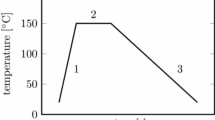Abstract
Pilot studies are conducted to characterize the macroscopic fracture resistance behavior using linear elastic fracture mechanics and attempt to quantify the fracture parameters in which may govern the fracture and failure patterns of stitched warp-knit fabric composites. Methods based on the J-integral method and Betti's reciprocal theorem in extracting the fracture parameters, critical stress intensity factors, T-stress, and the second term of σy(r,0) near the crack tip prior to fracture initiation are formulated. Two fracture criteria, [σc,r c] and [εc,r c] are attempted to characterize the failure initiation for the fiber-dominated failure mode and self-similar crack extension in a given thickness of the laminate. Based on linear elastic fracture mechanics principle, these criteria are transformed into crack-driving forces [K Q,T] and [K Q,g 32]. The two-parameter fracture criteria, [K Q,T] and [K Q,g 32] provide a good correlation for the CCT and SENT specimens, but not for the high constraint CT specimens. With the limited experimental data, the results tend to show that the large tensile T-stress and large magnitude of negative g 32 may inhibit the crack extension in the same crack plane and promote crack kinking.
Similar content being viewed by others
References
Wu, E.M. (1967). Application of fracture Mechanics to anisotropic plates. ASME Journal of Applied Mechanics 34, 967-974.
Beaumont, P.W.R. and Philips, D.C. (1972). Tensile strengths of notched composites. Journal of Composite Materials 6, 32-46.
Philips, D.C. (1974). The fracture mechanics of carbon fibre laminates. Journal of Composite Materials 8, 130-141.
Konish, H.J., Swedlow, J.L. and Cruse, T.A. (1973). Fracture phenomena in advanced fiber composite materials. AIAA Journal 11, 40-43.
Prewo, K.M. (1978). The effect of ply lay-up sequence on the fracture toughness of boron aluminum. Journal of Composite Materials 12, 40-52.
Waddoups, M.E., Eisenmann, J.R. and Kaminski, B.E. (1971). Macroscopic fracture mechanics of advanced composite materials. Journal of Composite Materials 5, 446-454.
Whitney, J.M. and Nusimer, R.J. (1974). Stress fracture criteria for laminated composites containing stress concentrations. Journal of Composite Materials 8, 253-265.
Masters, J.E. (1997). Translaminar fracture toughness of a composite wing skin made of stitched warp-knit fabric. NASA Contractor Report 201728.
Standard test method for plane-strain fracture toughness of metallic materials, ASTME 399-90. 1993 Annual Book of ASTM Standards.
Ting, T.C.T. (1996). Anisotropic Elasticity, Theory and Applications, Oxford University Press, Oxford.
Lekhnitskii, S.G. (1963). Theory of an Anisotropic Elastic Body, Holden-Day, San Francisco.
Yuan, F.G. (1998). Determination of stress coefficient terms in cracked solids for monoclinic materials with plane symmetry at x 3 D 0. NACA/CR-1998-208729, 1998.
Kfouri, A.P. (1986). Some evaluations of the elastic T-term using. Eshelby's Method. International Journal of Fracture 30, 301-315.
Wang, S.S., Yau, S.F. and Corten, H.T. (1980). A mixed-mode crack analysis of rectlinear anisotropic solids using conservation laws of elasticity. International Journal of Fracture 16, 247-259.
Wu, K.C. (1989). Representation of stress intensity factors by path-independent integrals. ASME Journal of Applied Mechanics 56, 780-785.
Poe, C.C., Jr. (1998). Private communications.
Rybicki, E.F. and Kanninen, M.F. (1977). A finite element calculation of stress intensity factors by a modified crack closure integral. Engineering Fracture Mechanics 9, 931-938.
Leevers, P.S. and Radon, J.C. (1983). Inherent stress biaxiality in various fracture specimen geometries. International Journal of Fracture 19, 311-324.
Yang, S. and Yuan, F.G. (2000). Kinked crack in anisotropic solids. International Journal of Solids and Structures 37, 6635-6682.
Author information
Authors and Affiliations
Rights and permissions
About this article
Cite this article
Yuan, F., Yang, S. Fracture behavior of stitched warp-knit fabric composites. International Journal of Fracture 108, 73–94 (2001). https://doi.org/10.1023/A:1007610908503
Issue Date:
DOI: https://doi.org/10.1023/A:1007610908503




